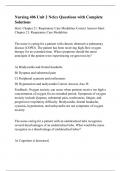Samenvatting
Volledige samenvatting Developmental biologie: 15/20 behaald!
- Instelling
- Katholieke Universiteit Leuven (KU Leuven)
A.d.h.v. de powerpoints + notities heb ik duidelijk samenvatting gemaakt van alle hoofdstukken die goed overzicht kunnen bieden. Daarnaast is het ook in het Engels geschreven (aangezien dit vak ook in het Engels wordt gegeven). Via goede titels en tussentitels is er een mooie structuur en opbouw ...
[Meer zien]











